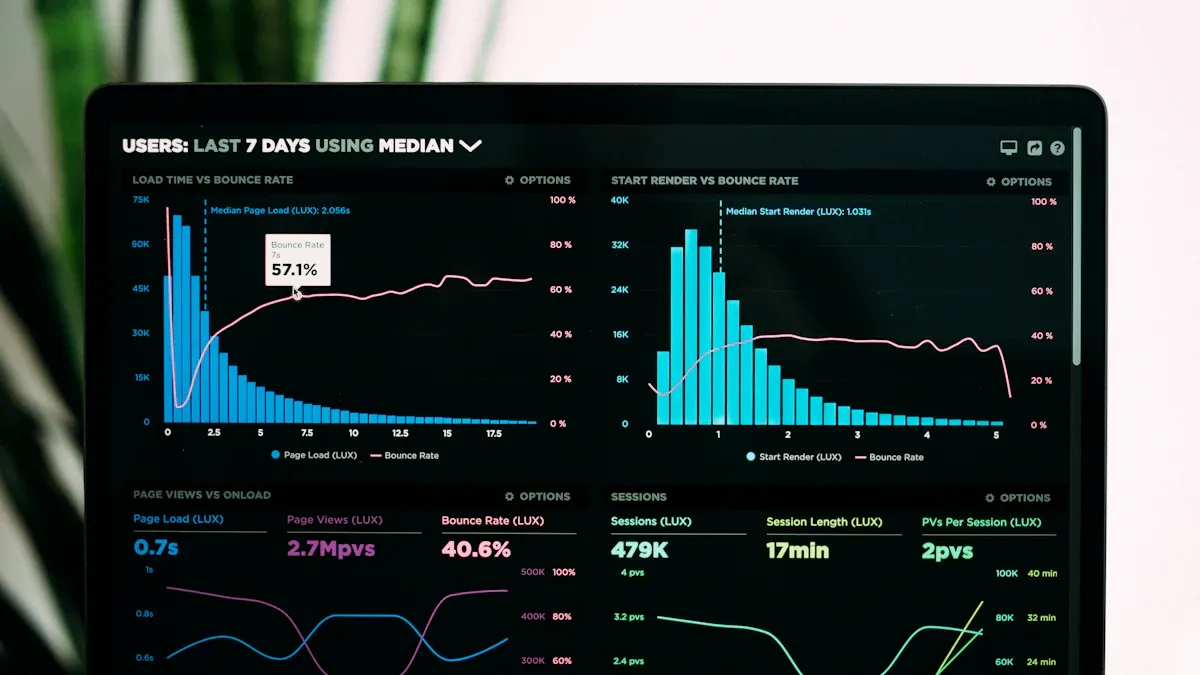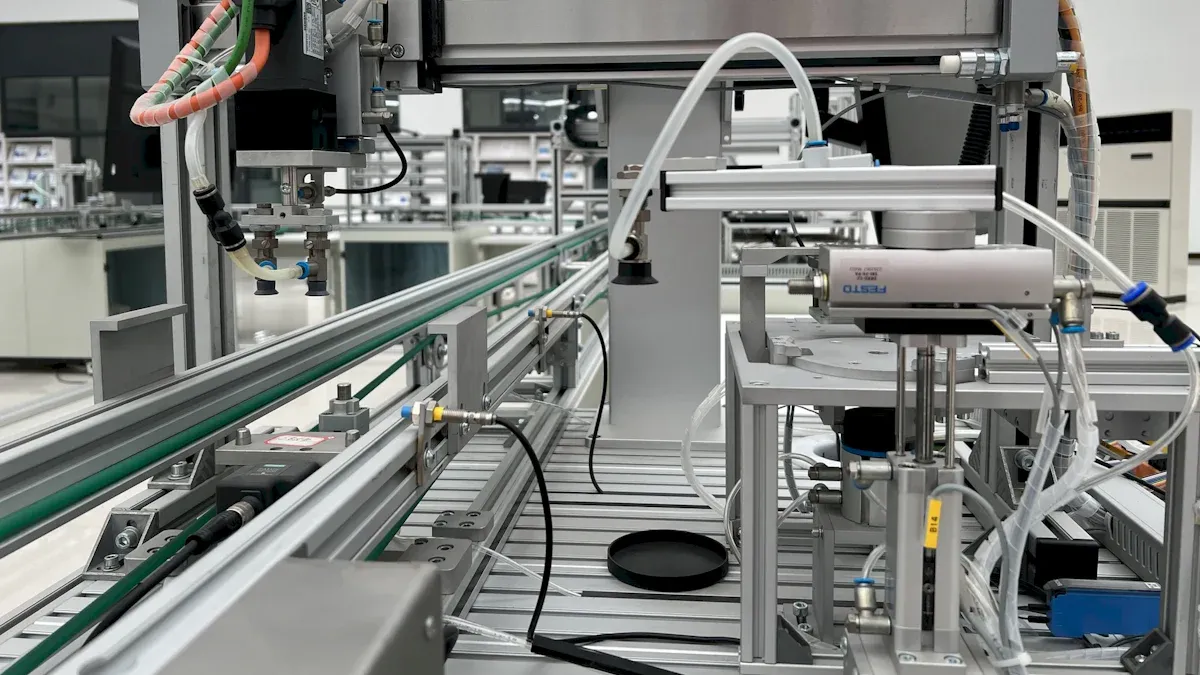SPC Explained: The Role of Statistical Process Control for Better Production Outcomes

Statistical process control (SPC) is a way to improve quality. It uses data to check and manage production processes. SPC helps find changes, keeping operations steady and reliable. For example, a car factory lowered defects by 37% in six months using SPC. Fixing small process changes, like a chip maker did to raise output by 18%, improves quality and saves money. With SPC, you make better products, waste less, and make customers happier. This gives your business an advantage over others.
What is Statistical Process Control?
Definition and core principles
Statistical process control (SPC) uses math tools to check production. Dr. Walter A. Shewhart created it in the 1920s. During World War II, it helped make better military supplies. Now, SPC is key to modern quality control. Today, 72% of factories use SPC, cutting defects by 25%. It finds changes in processes and keeps results steady.
SPC has important ideas:
Understanding Variation: It spots normal changes and big problems.
Process Stability: Stable processes give steady, expected results.
Continuous Improvement: SPC helps make processes better over time.
Prevention over Detection: Watching in real time stops problems early.
Data-Driven Decisions: Numbers guide how to manage processes.
These ideas help SPC keep production smooth and reliable.
The role of variation in production processes
Changes happen in every production process. But not all changes are alike. Common causes are small, normal changes, like tiny machine shifts. Special causes are big, unexpected problems, like broken machines or mistakes.
For example, in cereal packing, weight changes show if things are steady or not. SPC finds and fixes these changes to keep quality high. A study on sausage-making showed how charts track processes. This kept all samples within good limits. SPC helps keep production running well.
How SPC ensures process efficiency and quality
SPC keeps things efficient by stopping problems early. Tools like charts watch processes live and catch issues fast. For example, if a machine makes bad items, SPC alerts you to fix it. This saves materials and keeps quality high.
SPC also helps predict future results. When processes are steady, you can plan better and meet orders. This method improves products and builds customer trust.
Key Phases of Using Statistical Process Control
Finding and fixing big problems in production
All production has changes, but not all are bad. Some changes are normal, like small machine shifts. Others, called special causes, are big problems. These include things like machines breaking or power going out. For example, think of a computer freezing during an important task. Or imagine a traffic jam making deliveries late. These surprises can hurt quality and slow work.
To fix these problems, you must find their cause. Tools like control charts help spot strange patterns in data. When you see a problem, act fast to solve it. Training your team is also very important. A trained team can quickly notice and fix issues. This keeps work smooth and reduces mistakes.
Watching process stability over time
Keeping things steady is key for good quality. Checking your processes often helps keep them under control. Control charts are great tools for this. They show how things change over time and spot unusual changes. For example, a cereal company might use charts to check box weights. This ensures the weight stays within the right range.
Other tools, like process capability checks, see if your process meets quality rules. Watching your process all the time with live data helps too. Dashboards show how things are going and catch problems early. This keeps production steady and reliable.
Tool | What It Does |
|---|---|
Control Charts | Tracks process changes and finds normal or big problems. |
Process Capability Checks | Checks if the process makes products within quality limits. |
Live Monitoring | Watches process all the time to find and fix problems fast. |
Planning for future process success
SPC doesn’t just help now; it helps for later too. Looking at old data can show future problems before they happen. Predictive tools use past trends to guess what might go wrong. For example, smart computers can find patterns that warn of future issues. This helps stop problems before they start.
Adding tools like AI and predictive analytics makes SPC even better. These tools give tips to handle challenges and improve processes. By planning ahead, you can keep quality high and make customers happy.
Tools and Techniques in Statistical Process Control

Control charts and their types
Control charts are key tools in statistical process control. They track how processes change over time. These charts have two main limits: Upper Control Limit (UCL) and Lower Control Limit (LCL). These limits are set three standard deviations from the average. If the process is stable, most data points stay within these limits.
If you see patterns like a steady rise or repeated cycles, check for problems. For instance, if a machine makes heavier items often, it may need fixing. Different control charts are used for different tasks:
X-bar Chart: Tracks the average of samples, good for things like weight.
R Chart: Works with X-bar to check the range of data, keeping processes steady.
p Chart: Tracks the number of defective items, useful for pass/fail checks.
Control charts help find and fix problems early. This improves quality and saves time.
Process capability analysis
Process capability analysis checks if your process meets quality rules. It compares how much a process naturally changes to its limits. Indices like Cp, Cpk, Pp, and Ppk show how well the process works:
Capability Index | What It Shows |
|---|---|
Cp | Checks the process's potential to meet limits. |
Cpk | Shows if the process is centered correctly. |
Pp | Looks at long-term process potential. |
Ppk | Measures long-term performance with shifts. |
For example, a high Cp means the process can meet limits. But a low Cpk shows the process might not be centered. By studying these numbers, you can find ways to improve and keep quality steady.
Other essential SPC tools
Other tools also help in statistical process control. Regression analysis shows how things are connected. Hypothesis testing checks if changes affect the process. Design of Experiments (DOE) tests many factors to find the best settings. These tools, along with live monitoring, help keep quality high and reduce mistakes.
Tip: Using these tools with AI can help predict and stop problems, making your process even better.
Benefits of Implementing Statistical Process Control
Better product quality and consistency
Statistical process control (SPC) helps keep product quality steady. It finds and fixes changes in production quickly. Tools like control charts let you watch processes live and spot problems fast. For example, a food factory improved safety and cut process changes by 25% using SPC. This helped them follow rules and make their work better.
SPC also makes products more uniform. By studying data, you can see patterns and fix issues early. An electronics company boosted efficiency by 20% and made customers happier with SPC. These examples show how SPC improves production and builds trust in your brand.
Less waste and lower costs
Using SPC cuts waste by stopping mistakes and improving work. Watching processes closely prevents bad products from being made. This saves materials and reduces costs. Studies show poor quality can waste up to 20% of revenue. SPC helps lower this number a lot.
One company saved $300,000 a month after starting SPC. Waste dropped from 20% to 8%, and daily output rose from 1,000 to 1,400 units. These changes show how SPC makes work smoother and increases profits.
Metric | Before SPC Use | After SPC Use |
|---|---|---|
Costs | $1M/month | $700K/month |
Waste | 20% | 8% |
Output | 1,000 units/day | 1,400 units/day |
Happier customers and stronger trust
Good quality products make customers happy. SPC helps by reducing defects and making items reliable. For example, a medical device company had 45% fewer complaints after using SPC. This made customers happy and improved their reputation.
Happy customers stay loyal to your brand. SPC helps keep quality high, building trust over time. Fewer problems mean fewer complaints and a better image for your business.
Tip: Keeping quality steady builds trust. Use SPC tools to improve your processes all the time.
Real-World Applications of Statistical Process Control

Examples from manufacturing industries
Statistical process control (SPC) helps factories work better and make fewer mistakes. For example, a car company used charts to check quality. This cut defects by 30% and saved $1.5 million each year. These results show how SPC keeps quality steady and lowers costs.
Many industries depend on SPC to keep high standards:
Car makers use SPC to reduce waste and improve engine and assembly quality.
Medicine companies use SPC to check temperature and ingredient amounts. This ensures safe and consistent medicines.
Using SPC helps factories make better products, waste less, and satisfy customers.
Applications in service industries
SPC is useful outside factories too. Service businesses use it to improve their work and keep customers happy. For example:
Call centers track call times and satisfaction rates with SPC. This makes service faster and better.
Banks use SPC to check transaction times and errors. Charts find problems, making services safer and quicker.
These examples show SPC helps many businesses work better and serve customers well.
Note: SPC works for both making products and providing services.
Role of SPC in continuous improvement initiatives
Improving all the time is key to staying ahead. SPC helps by finding problems and tracking progress. For example, Motorola used SPC to make products better. They saved over $16 billion by fixing defects and improving production.
SPC’s impact on improvement is clear:
Metric | Before SPC Use | After SPC Use |
|---|---|---|
Defect Rate | 15% | 4% |
Production Efficiency | 75% | 88% |
Customer Returns | 5% | 1% |
By studying data and fixing issues early, SPC helps keep quality high and ensures success over time.
FAQ
What is the main goal of Statistical Process Control (SPC)?
SPC helps check and improve how things are made. It keeps processes steady, reduces changes, and improves product quality. SPC finds problems early, stops defects, and keeps results consistent.
How do control charts work in SPC?
Control charts show data over time to check process limits. They spot unusual patterns or changes. This helps you fix problems before they lower quality.
Can SPC be used outside of manufacturing?
Yes, SPC works in other areas too. For example, banks use it to check transaction times. Call centers track customer happiness with SPC. It helps improve work in many fields.
What are the benefits of using SPC?
SPC makes products better, cuts waste, and saves money. It also makes customers happy by keeping results steady. These benefits help your business stay ahead.
Is SPC difficult to implement?
SPC needs training and tools, but it’s not too hard. Start with simple charts and grow from there. With practice, you’ll see better processes and quality.
See Also
Navigating CBAM: A Supplier's Guide to Sustainable Casting
Exploring QFD, FMEA, and DOE's Impact on Quality Manufacturing
Understanding Functional Testing in CNC and Die Casting Methods
The Advantages of CAE Analysis in Die Casting Design
Top 10 Surface Finishing Techniques for Metals to Learn
About Hunan Puka
Established in 2016 and based in Hunan, China, with a liaison point in Berlin, we are a Tier 2 supplier for the automobile industry. We specialize in the production of customized aluminum die-casting parts designed for machines with a closing force ranging from 280 to 1250 tons, with subsequent manufacturing process CNC machining and surface treatment. Our commitment to quality is reflected in our accredited quality management system, certified by ISO9001:2015 and IATF16949:2016 standards.


